Dell introduced the new and improved Alienware Aurora R15 earlier this year in India. Currently the most powerful gaming tower offering from the company, you don’t get a variety of SKUs, but it is being offered in two high-end configurations. According to Dell, it has made attempts to address the concerns of its consumers and has improved on three aspects -cooling, power and acoustics. It is claimed to offer up to 5% lower CPU temperatures at the same time delivering 68 percent more power.
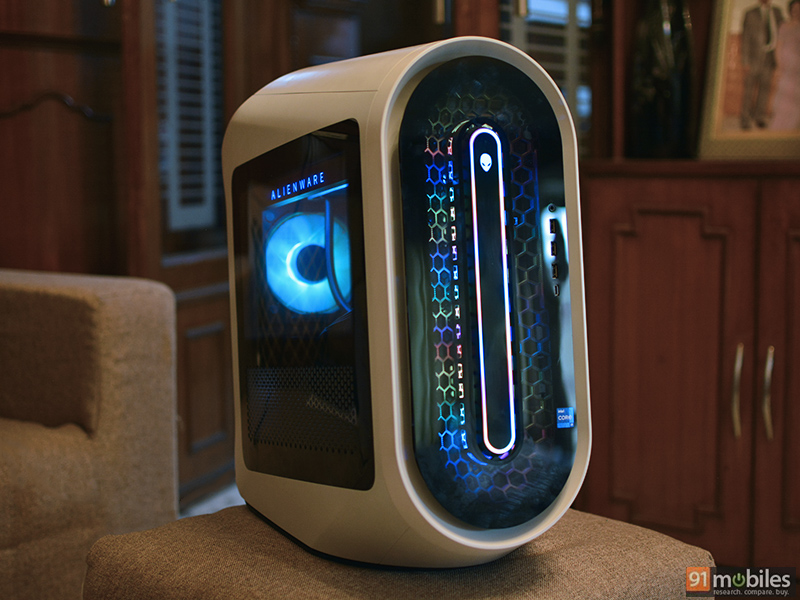
The new Alienware Aurora R15 desktop has been updated with the latest Intel 13th-gen Raptor Lake processors and Nvidia’s GeForce RTX 40 series desktop GPUs. You can get this beast with either the Core i7-13700KF paired with the RTX 4080 or the more powerful Core i9-13900KF with an RTX 4090. The former is configured with a single 16GB DDR5 4800MHz memory module, which is weird as dual channel is the way to go. Thankfully Dell doesn’t commit the same mistake on the more expensive unit as you get 32GB DDR5 4800MHz memory in dual channel, which is also the one I got for testing. Both variants also come with a 512GB PCIe Gen 4 NVMe SSD and a 1TB 7,200RPM hard drive. Prices start at Rs 4,06,990 for Core i7 + RTX 4080 combo and Rs 5,44,489 for the Core i9 + RTX 4090.
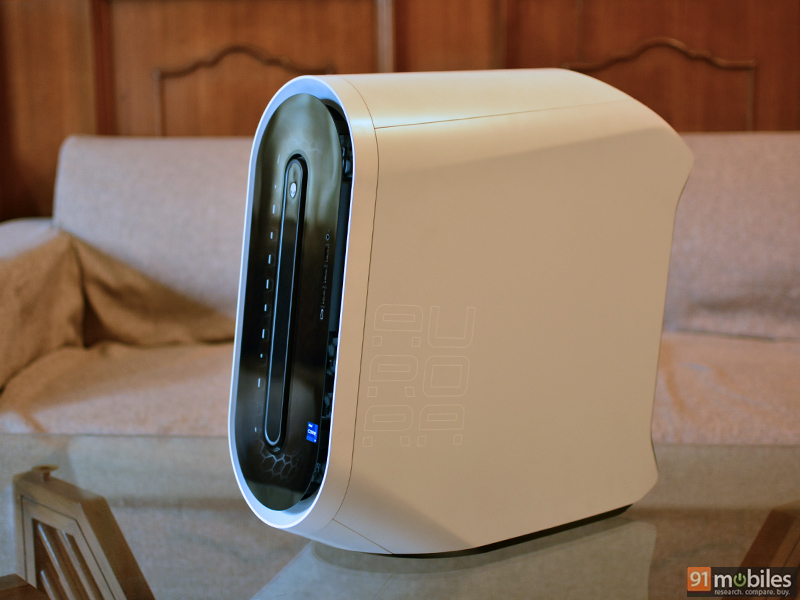
The chassis and design roll over from what we saw last year on the Aurora R13 and R14 gaming desktops. It looks very similar from the outside with only minor changes. The acrylic window on the side panel now has honeycomb-shaped perforations at the bottom to provide the GPU with better access to air increasing intake efficiency. The company has also updated the CPU cooler to a modest 240mm AiO liquid cooling solution, a well-needed upgrade from the previous 120mm liquid cooler.
While it is easy to fall in love with how good this machine looks in terms of design and on paper, there’s a lot more to it.
What works
- The Aurora R15 offers a unique space-age vibe which is what one expects from an Alienware machine. The white and black aesthetics are a head turner with tasteful RGB at the front, the rear exhaust fan, the liquid cooler pump head and a light bar with the Alienware branding. All of the lighting can be controlled using the Alienware Command Center software which includes a wide range of colours and a handful of patterns to play with. There’s also some subtle Aurora branding on the rear panel and you get an additional cable cover with a honeycomb pattern that attaches magnetically to the rear of the cabinet. It isn’t really necessary, but it does complete the look of the machine.
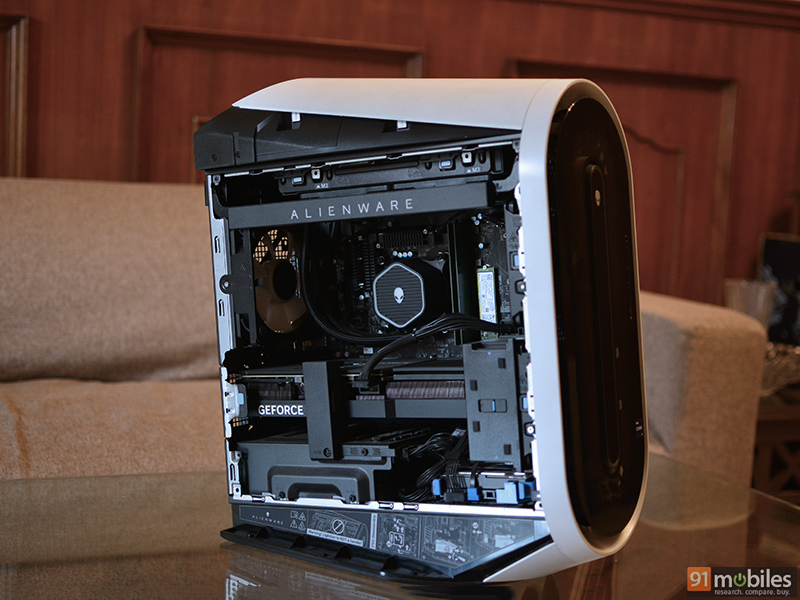
- Packed with the latest power-oriented hardware, the Aurora R15 offers class-leading performance. The Intel Core i9-13900KF features a total of 24-cores, 32-threads with boost clock speeds of up to 5.8GHz and a TDP of 253W. Paired with 32GB of DDR5 dual channel memory at 4800MHz and a fast PCIe Gen 4 SSD, expect lightning-fast operations with seamless multitasking. Then there is the mighty Nvidia GeForce RTX 4090, the top-of-the-line graphics card available on the market today. The combination of all the hardware translates to an impressive experience. Minor nitpick, but instead of the Core i9-13900KF, it would make a lot of sense to offer the Core i9-13900K as it comes with integrated graphics that can be a lifesaver if something goes wrong with the dedicated graphics card.
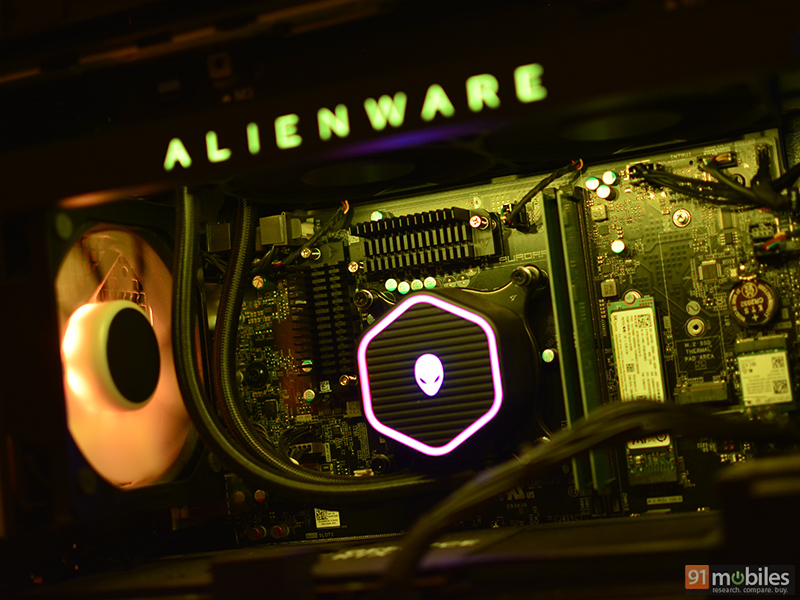
- In terms of core CPU performance the Core i9-13900KF can be pushed to the limits, thanks to the inclusion of a 240mm AiO liquid cooler. The CPU managed to reach its potential scoring some impressive points in various benchmarks. In Cinebench R23 the system scored 31189 points in the multi-core benchmark and 17209 points on Geekbench 6. Check out all the benchmark scores below:
- The Aurora R15 is built for gaming, and it shines in this segment. The RTX 4090 is capable of handling AAA gaming titles at 4K resolution, but sadly I did not have access to a 4K monitor while testing the machine. However, I did test its capabilities on my 1080p monitor. Starting off with Cyberpunk 2077, I got an average of 183fps on the Ray Tracing: Overdrive graphics setting with DLSS frame generation enabled. Disabling DLSS frame generation on the same graphics settings pulled the average frame rates down to 111fps, which is still pretty impressive. In Forza Horizon 5 I got an average of 195fps at Extreme graphics settings and about 186fps with ray tracing enabled. Both Horizon Zero Dawn and Rise of the Tomb Raider ran at over 200fps at the maximum graphics settings.
| Games at 1080p | Medium | High | Ultra |
| Cyberpunk 2077 (Ray tracing and DLSS frame generation) | 254fps | 241fps | 183fps |
| Metro Exodus Enhanced (Ray tracing and DLSS) | 138fps | 129fps | 124fps |
| Forza Horizon 5 | 253fps | 212fps | 195fps |
| Horizon Zero Dawn | 237fps | 227fps | 216fps |
| Rise of the Tomb Raider | 285fps | 280fps | 277fps |
- As per the design, the chassis doesn’t seem very optimised for proper airflow. The front has a 120mm intake fan although there isn’t a lot of space as it is mostly blocked by the acrylic panel. For exhaust there is a 120mm fan at the rear while the tower has a small section at the top to exhaust hot air. Thankfully the GPU gets enough air via the ventilation holes on the side panel. I was surprisingly pleased with the temperatures and thermal performance. The CPU reached peak temperatures of 97℃ during synthetic benchmark testing and I didn’t notice any thermal throttling. Similarly, the GPU only peaked around 78℃ but during gameplay it remained just below 70℃. Despite having a poor internal design, the chassis clearly manages to offer enough airflow to keep the CPU and GPU thermals under control.
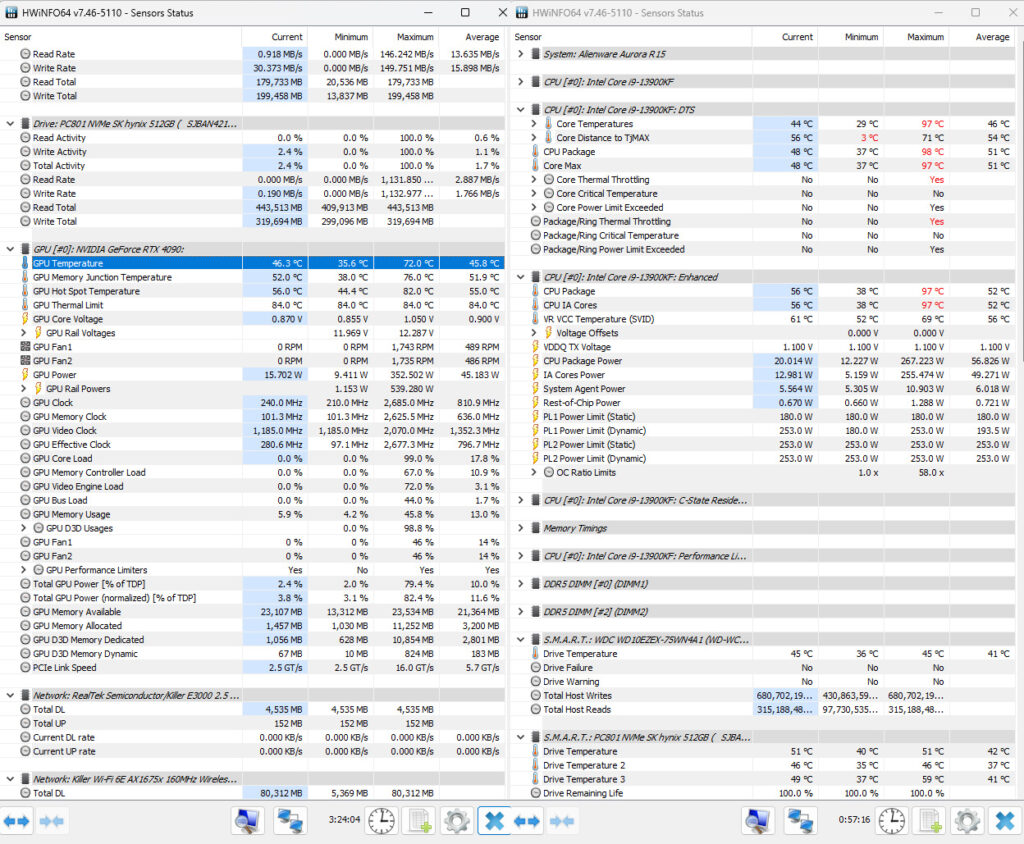
- I would also like to mention that Dell hasn’t skimped in the I/O department. In fact, there is plenty to choose from. At the front, there is a headphone out jack, two USB 3.2 Gen 1 ports, a USB 3.2 Gen 1 port with PowerShare, and a USB 3.2 Gen 2 Type-C port with PowerShare. At the back there is a rear surround out, SPDIF digital out, SPDIF coax digital out, side surround out, centre/subwoofer out, line-in, microphone in, line out, a USB 3.2 Gen 2 Type-C (10Gbps), a USB 3.2 Gen 2×2 Type-C (20Gbps), two USB 2.0 Type A with Smart Power, two USB 2.0 Type A, two USB 3.2 Gen 1 Type-A (5Gbps), and an RJ-45 Killer E3100 Gigabit Ethernet. On the graphics card, you get three DisplayPort 1.4 and an HDMI 2.1 port. There is also an additional M.2 slot that can accommodate a secondary SSD if you wish to add one in the future.
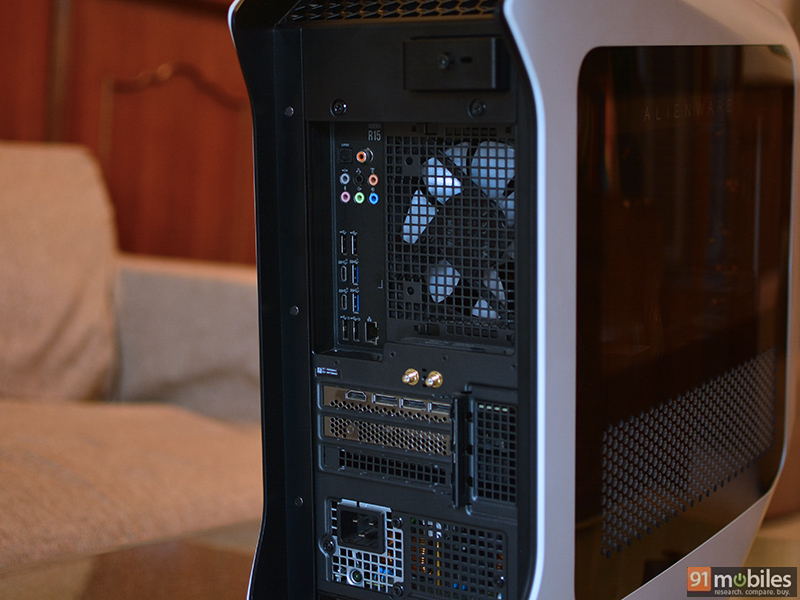
What doesn’t work
- Pivoting from the greatness offered by the Aurora R15, let’s now talk about its shortcomings. While the design of the tower is spectacular, there is a lot to talk about the internals. As mentioned above, Dell has slapped some panels on a legacy chassis and it doesn’t look like a modern PC from the inside. The front could use proper ventilation or at least a removable panel as dust buildup is going to be an issue, especially in India. Even removing components like the GPU, power supply and motherboard is not quite straightforward and requires a lot of patience.
- This brings us to the upgradeability options. The motherboard and the power supply are proprietary thus restricting future upgrades. While you can swap out the memory and storage, the GPU has a dedicated bracket that holds it in place, although theoretically, one can replace it if required in the future. It is also worth noting that the power cord comes with a large 16A plug which can be an issue if you don’t have a large power socket near your desk. Replacing the power cord isn’t really an option either, as the power supply comes with C19 server pins, which is not the same as a regular power supply. Also, it would be nice if Dell can offer better-looking RAM sticks, at least with some shielding instead of the boring green chips. Even the storage options are disappointing, I mean why would you use a hard disk drive on a gaming PC when SSDs prices are nearly the same?
- The biggest issue with the Aurora R15, however, is its price. It isn’t surprising to see an Alienware machine cost this much, but it doesn’t add up. Yes, you get a unique design language and justified performance, but considering the cost-cutting it is insane to see Dell charging over Rs 5 lakhs for this configuration. One can definitely get a system built with the same components for under Rs 4 lakhs. I have even added a configuration below to get an estimated cost of all the components if you happen to build your own PC.
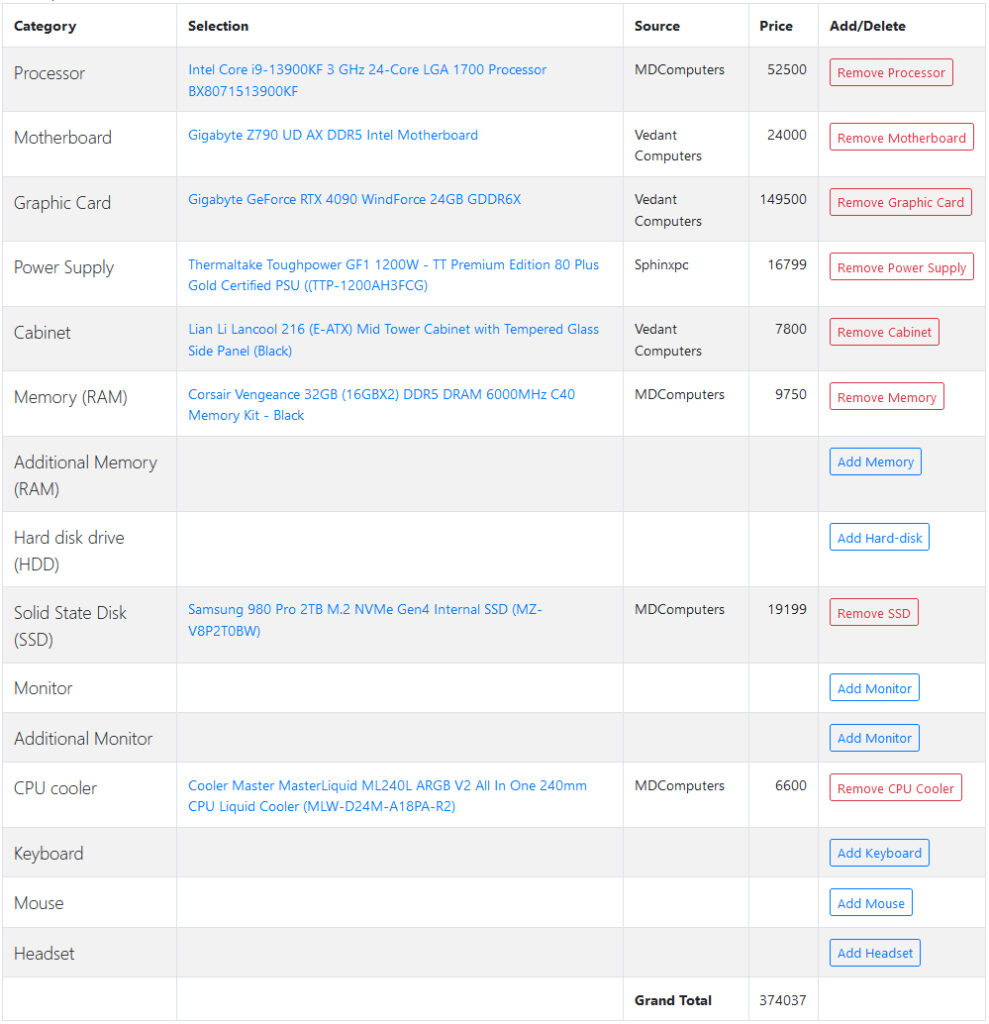
Verdict
The new Alienware Aurora R15 is a solid option for someone who is looking for top-of-the-line computing performance, specifically if you don’t want to go through the hassle of sourcing parts and building a PC on your own. Be it 4K gaming or high-end studio work, this beast manages to deliver without any hiccups. On top of that, it looks absolutely stunning with its black-and-white aesthetics bedazzled with RGB lighting. With minor tweaking like a larger liquid cooler and some ventilation for the GPU, Dell has also managed to improve the thermal performance, especially when compared to last year’s model.
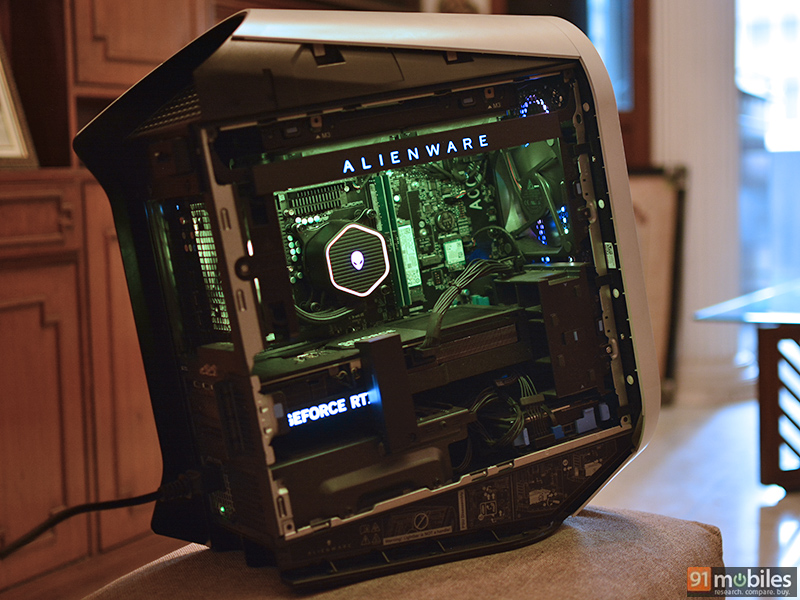
It isn’t the perfect gaming machine though as it does have shortcomings. First and foremost, it has a steep price which doesn’t completely justify what you actually get. It is also limited in terms of future upgrades and just like a laptop, you can only upgrade the RAM or storage, and in some cases, the graphics card. There are also a few kinks here and there that can potentially hinder the experience as a whole. But, if you can overlook these concerns, then the Aurora R15 is a highly recommended performance-oriented gaming tower.
Editor’s rating: 4 / 5
Pros:
- Excellent performance
- Stable thermal performance
- Space age design
- Wide range of I/O ports
Cons:
- Limited scope of upgrades
- Very expensive
- Legacy internal chassis design
- HDD secondary storage
The post Dell Alienware Aurora R15 review: skyrocketing performance without breaking a sweat first appeared on 91mobiles.com.
0 Comments